ZHCSBQ3B October 2013 – July 2014 TPS92411
PRODUCTION DATA.
- 1 特性
- 2 应用
- 3 说明
- 4 修订历史记录
- 5 Pin Configuration and Functions
- 6 Specifications
- 7 Detailed Description
- 8 Application and Implementation
- 9 Power Supply Recommendations
- 10Layout
- 11器件和文档支持
- 12机械封装和可订购信息
封装选项
机械数据 (封装 | 引脚)
散热焊盘机械数据 (封装 | 引脚)
- DDA|8
订购信息
6 Specifications
6.1 Absolute Maximum Ratings
All voltages are with respect to VS, –40 °C < TJ = TA ≤ 150 °C. All currents are positive into and negative out of the specified terminal (unless otherwise noted).| MIN | MAX | UNIT | ||
|---|---|---|---|---|
| Supply voltage | VIN | –0.3 | 105 | V |
| Switch voltage | DRAIN | –0.3 | 105 | |
| Junction temperature | TJ | –40 | 165 | ºC |
6.2 Handling Ratings
| MIN | MAX | UNIT | |||
|---|---|---|---|---|---|
| Tstg | Storage temperature range | –65 | 150 | °C | |
| V(ESD) | Electrostatic discharge | Human body model (HBM), per ANSI/ESDA/JEDEC JS-001, all pins(1) | 1 | kV | |
| Charged device model (CDM), per JEDEC specification JESD22-C101, all pins(2) | 250 | V | |||
(1) JEDEC document JEP155 states that 500-V HBM allows safe manufacturing with a standard ESD control process.
(2) JEDEC document JEP157 states that 250-V CDM allows safe manufacturing with a standard ESD control process.
6.3 Recommended Operating Conditions
Over operating free-air temperature range (unless otherwise noted)| MIN | TYP | MAX | UNIT | |||
|---|---|---|---|---|---|---|
| VIN | Input voltage | TPS92411P | 7.5 | 94 | V | |
| TPS92411 | 7.5 | 100 | ||||
| TJ | Operating junction temperature | –40 | 25 | 150 | °C | |
6.4 Thermal Information
| THERMAL METRIC(1) | TPS92411 | UNIT | ||
|---|---|---|---|---|
| DBV | DDA | |||
| 5 PINS | 8 PINS | |||
| θJA | Junction-to-ambient thermal resistance(2) | 209.8 | 58.6 | °C/W |
| θJCtop | Junction-to-case (top) thermal resistance(3) | 125.2 | 72 | |
| θJB | Junction-to-board thermal resistance(4) | 38 | 39.1 | |
| ψJT | Junction-to-top characterization parameter(5) | 15.6 | 21.6 | |
| ψJB | Junction-to-board characterization parameter(6) | 37.1 | 39.1 | |
| θJCbot | Junction-to-case (bottom) thermal resistance(7) | N/A | 15 | |
(1) For more information about traditional and new thermal metrics, see the IC Package Thermal Metrics application report, SPRA953.
(2) The junction-to-ambient thermal resistance under natural convection is obtained in a simulation on a JEDEC-standard, high-K board, as specified in JESD51-7, in an environment described in JESD51-2a.
(3) The junction-to-case (top) thermal resistance is obtained by simulating a cold plate test on the package top. No specified JEDEC-standard test exists, but a close description can be found in the ANSI SEMI standard G30-88.
(4) The junction-to-board thermal resistance is obtained by simulating in an environment with a ring cold plate fixture to control the PCB temperature, as described in JESD51-8.
(5) The junction-to-top characterization parameter, θJT, estimates the junction temperature of a device in a real system and is extracted from the simulation data for obtaining θJA, using a procedure described in JESD51-2a (sections 6 and 7).
(6) The junction-to-board characterization parameter, θJB, estimates the junction temperature of a device in a real system and is extracted from the simulation data for obtaining θJA, using a procedure described in JESD51-2a (sections 6 and 7).
(7) The junction-to-case (bottom) thermal resistance is obtained by simulating a cold plate test on the exposed (power) pad. No specific JEDEC standard test exists, but a close description can be found in the ANSI SEMI standard G30-88.
6.5 Electrical Characteristics
Unless otherwise specified –40 °C ≤ TJ = TA ≤ 150 °C, (VVIN – VVS) = 30 V, RRSET = RRSNS = Open, all voltages are with respect to VS.| PARAMETER | TEST CONDITIONS | MIN | TYP | MAX | UNIT | ||
|---|---|---|---|---|---|---|---|
| INPUT SUPPLY (VIN) | |||||||
| VIN(ovp) | Input overvoltage protection | TPS92411P | Rising threshold | 95 | 100 | V | |
| Falling threshold | 96 | ||||||
| Hysteresis | 4 | ||||||
| IQ | Bias current | 200 | 400 | μA | |||
| VIN(uvlo) | Input undervoltage lockout | Rising threshold | 6.5 | 7 | V | ||
| VIN(hys) | Input UVLO hysteresis | 370 | mV | ||||
| SWITCH CONTROL (RSNS, RSET) | |||||||
| IRSNS | RSNS threshold current | –3.3 | –4 | –4.9 | μA | ||
| VRSNS_OS | RSNS offset voltage | 165 | 210 | 255 | mV | ||
| VRSET | RSET threshold voltage | 1.2 | 1.25 | 1.3 | V | ||
| IRSET | RSET current | IRSNS = –20 μA, (VRSET – VVS) = 1.5 V | –9.3 | –10 | –10.7 | μA | |
| IRSNS = –40 μA, (VRSET – VVS) = 1.5 V | –19 | –20 | –21 | ||||
| IRSNS = –100 μA, (VRSET – VVS) = 1.5 V | –47.9 | –50 | –52.1 | ||||
| SWITCH (DRAIN, VS) | |||||||
| RDS(on) | On-resistance | IDRAIN = 100 mA, TJ = 25°C | 1 | 2 | 2.5 | Ω | |
| dv/dt(ON) | Switch ON slew rate | (VDRAIN – VVS) falling 36 V to 4 V, ISW = 100 mA |
1 | V/μs | |||
| dv/dt(OFF) | Switch OFF slew rate | (VDRAIN – VVS) = rising 4 V to 36 V, ISW = 100 mA |
0.5 | ||||
6.6 Typical Characteristics
Unless otherwise stated, –40 °C ≤ TA = TJ ≤ 150 °C, (VVIN – VVS) = 30 V, all voltages are with respect to VS.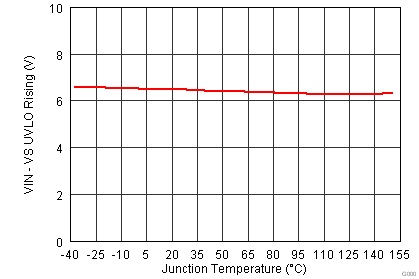 Figure 1. UVLO vs. Temperature
Figure 1. UVLO vs. Temperature
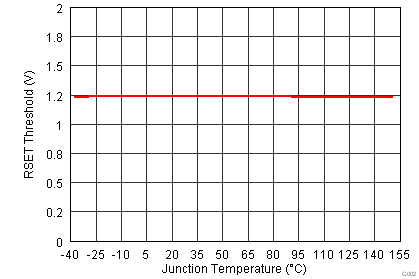 Figure 3. RSET Threshold vs. Temperature
Figure 3. RSET Threshold vs. Temperature
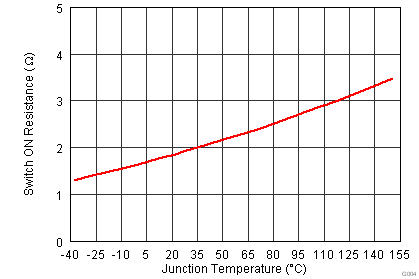 Figure 5. Switch On-Resistance (RDS(on)) vs. Temperature
Figure 5. Switch On-Resistance (RDS(on)) vs. Temperature
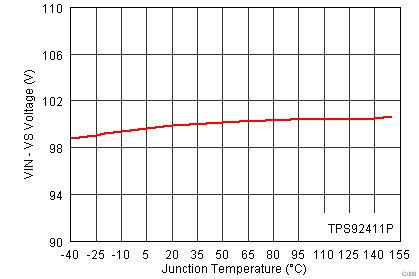 Figure 7. (VVIN – VVS) Overvoltage Threshold vs. Temperature
Figure 7. (VVIN – VVS) Overvoltage Threshold vs. Temperature
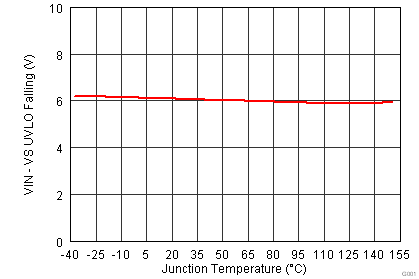 Figure 2. UVLO vs. Temperature
Figure 2. UVLO vs. Temperature
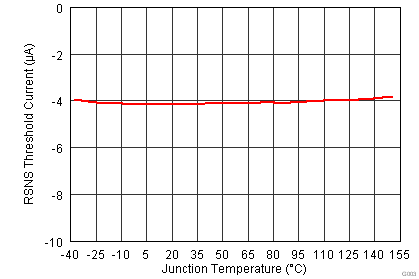 Figure 4. RSNS Threshold Current vs. Temperature
Figure 4. RSNS Threshold Current vs. Temperature
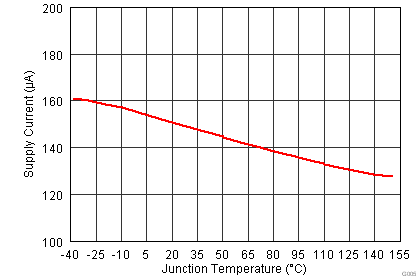 Figure 6. Input Voltage Quiescent Current vs. Temperature
Figure 6. Input Voltage Quiescent Current vs. Temperature